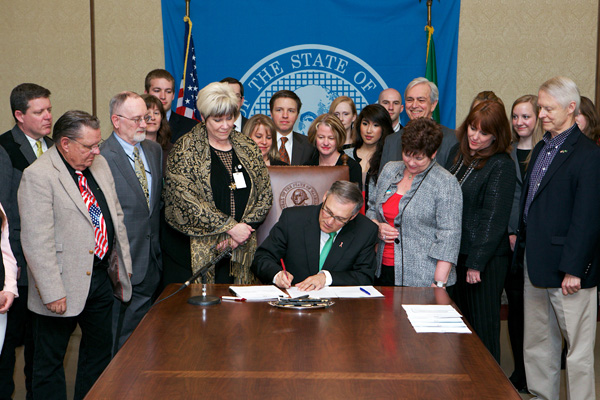Long battle for Top 2 Primary officially over
(Photo courtesy of Legislative Support Services, Photo Department)
It was a quiet, noncontroversial ending to a 12-year legal, legislative and ballot-box battle to preserve a wide-open primary system for Washington voters. The fight had involved the political parties, the highest court in the land, and even a detour through California.
Gov. Jay Inslee signed Senate Bill 5518 to clear the state law books of all references to the much-maligned Pick-a-Party system that voters were required to use in 2004 through 2007 while litigation raged.
Secretary of State Kim Wyman and her predecessor, Sam Reed, and officials of the State Grange watched happily as the new law was signed, leaving the voter-approved, court-blessed Top 2 Primary as THE system for Washington.
Reed, who worked with the Grange on a successful citizen Top 2 initiative in 2004, said the bill-signing was great closure to his 12-year battle. Wyman agreed, saying the state’s primary system squares perfectly with the state’s ticket-splitting, independent-minded political tradition.
Senate sponsors, Pam Roach of Auburn and Jeannie Darneille of Tacoma, attended the signing ceremony at the Capitol. House sponsors included Reps. Sam Hunt of Olympia, David Taylor of Moxee and Vincent Buys of Lynden.
The story actually began in 2000, when the U.S. Supreme Court ruled that a “blanket primary,” pioneered by Washington state back in 1935, was unconstitutional because it allowed voters to cross party lines and vote for their favorite for each office, without regard to party label. The lawsuit arose out of California, where voters had approved the Washington-style primary by initiative in 1996.
The high court agreed with the parties that the system, which produced a General Election nominee for each major party, violated their constitutional right of association — in other words, outsiders were allowed to help determine the parties’ nominees. Reed and the Grange then turned to the Top 2 idea, which allows crossover voting and produces two finalists for each office, not party nominees. As always, Washington voters do not register by party. Candidates identify their party preference, but that doesn’t signify that the party endorses or favors them.
When then-Gov. Gary Locke vetoed the Legislature’s preferred option, the Top 2, in spring of 2004, that left in place the “Pick-a-Party” primary that restricted each voter to only one party’s line of candidates. It was widely unpopular and at the November election that year, voters gave strong approval to a Reed-Grange initiative restoring the Top 2 Primary.
But before it could go into effect, the political parties sued, asserting infringement of right of association and voter confusion. They won at District and Appeals Court, but the U.S. Supreme Court overturned in 2008, saying the Top 2 isn’t inherently flawed and that further constitutional challenges would hinge on how it is implemented. The parties continued their challenge, but lost their as-applied challenge in federal courts.
The state had used a roadmap from the high court itself suggesting a constitutional way to have a Top 2.
The parties continued to fight, rejecting Reed’s steadfast pleas to drop their lawsuit against the voters. Eventually, the high court declined to review the 9th Circuit decision in favor of Top 2. The parties kept litigating, although Republicans eventually dropped out and eventually the Democrats and Libertarians did, too.
The legislation to remove the now-outdated references to the Pick-a-Party system finally got a green light and zipped through Olympia. It also updated references to the timing of the primary and filing deadlines, took out references to invalidated provisions like term limits, residency requirements for Superior Court judges, and so on.
